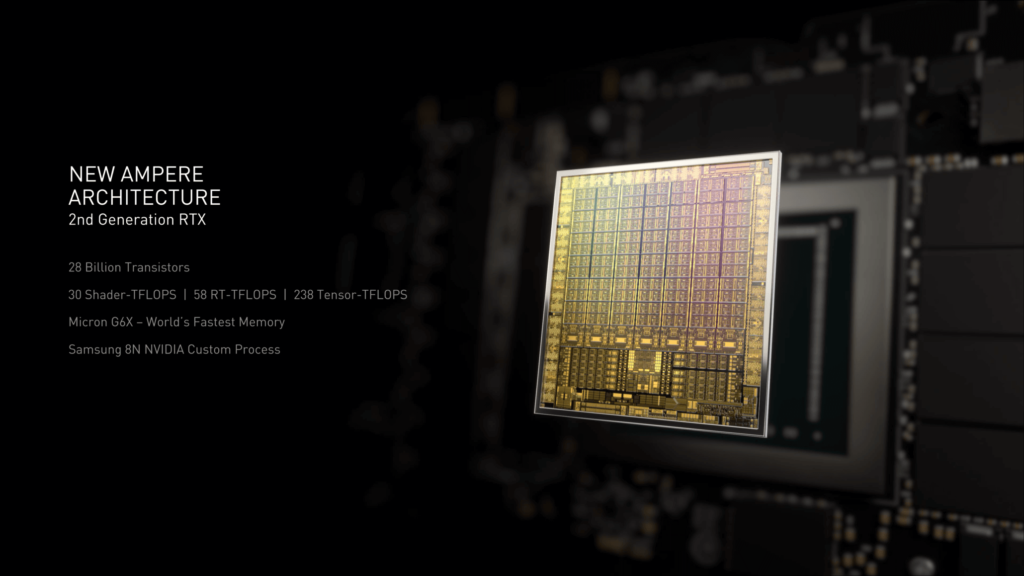Keeping with their tradition of releasing a new graphics architecture every two years, NVIDIA introduced the Ampere GPU this year. Ampere GPU is built on the foundation laid by Turing. Described as the most significant generational leap, NVIDIA Ampere GPUs outperform previous generations in every way.
The Ampere range delivers faster shader performance, ray tracing performance, and AI performance. Built on an entirely new functional node and featuring architecture designed from the ground up, Ampere is a killer product with plenty of numbers to talk about. The essence of Ampere was to take everything NVIDIA had learned through the Turing architecture and not only improve it but also use its DNA to shape a product in an entirely new performance class.
Today, we will be looking at the NVIDIA GetForce RTX 3090 Ti 24 GB graphics card, a monster of a graphics card featuring the full-fat GA102 GPU.
NVIDIA GeForce RTX 30 Series Gaming Graphics Cards – The Biggest GPU Performance Leap in Recent History
Turing wasn’t just any graphics core, and the graphics core was the basis for future GPUs. The future is now being realized with next-generation consoles that delve into conversations about ray tracing and superior AI-assisted sampling techniques. NVIDIA had a head start with Turing, and the Ampere generation would do things infinitely better.
The Ampere GPU does many traditional things that we would expect from a GPU but, at the same time, also breaks the barrier when it comes to untraditional GPU operations. Just to sum up some features:
- New Streaming Multiprocessor (SM)
- New Turing Tensor Cores
- New Real-Time Ray Tracing Acceleration
- New Shading Enhancements
- New Deep Learning Features For Graphics & Inference
- New GDDR6X High-Performance Memory Subsystem
- New 2nd Generation NVLINK Interconnect
- New HDMI 2.1 Display Engine & Next-Gen NVENC/NVDEC
If you’re gaming at 4K 60FPS with ray tracing enabled or 4K 120FPS without ray tracing enabled (and both with DLSS), then the GeForce RTX 3080 Ti and GeForce RTX 3090 are usually the ones you’d flock towards. But now that the GeForce RTX 3090 Ti is here, well, that’s what this review is here for — but you know the spoiler — the RTX 3090 Ti is now the best, the very best GPU on the market.
NVIDIA’s new GeForce RTX 3090 Ti is giving me TITAN RTX vibes, which was a ridiculous over-the-top GPU with a huge amount of VRAM at the time — 24GB — a lot of VRAM for a GPU released in 2013, nearly ten years ago now. There’s also 24GB of GDDR6X memory on the GeForce RTX 3090 Ti, which is now tuned up and clocked at 21Gbps with over 1TB/sec of memory bandwidth.
The new GeForce RTX 3090 Ti is a massive upgrade for 4K and, better yet, 8K gamers — and then even better again for content creators you’ve got the most wicked-fast Ampere GPU ever made, as well as a huge and now even faster 24GB of GDDR6X memory.
NVIDIA GetForce RTX 30 Series Pricing Per Segment
NVIDIA’s GetForce RTX 30 series comprises a diverse portfolio of graphics cards. The lineup starts at the GetForce RTX 3060 with an MSRP of $329 US and goes all the way up to higher-end configurations starting at $499 US for the GeForce RTX 3070, $599 US for the GeForce RTX 3070 Ti, $699 US for the GeForce RTX 3080, $1199 US for the GeForce RTX 3080 Ti and $1499 US for the GeForce RTX 3090. NVIDIA themselves call the GeForce RTX 3080 Ti the flagship graphics card and not the GeForce RTX 3090. With the arrival of the GeForce RTX 3090 Ti, we now have a new ultra-premium card starting at $1999 US.
The RTX 3080 & RTX 3070 are both priced well and in line with their predecessors, but the GeForce RTX 3090 goes all out with $1499 US. Even the GeForce RTX 3080 Ti has seen a price hike compared to the MSRP of the RTX 2080 Ti ($999 US vs $1199 US). NVIDIA calls the GeForce RTX 3090 the “BFGPU”, and as per the terminology, it seems like this is a new marketing name for the Titan graphics card. We could likely see a Titan-based card under the Quadro branding with faster specs out of the box. Still, the GeForce RTX 3090 is purely a gaming graphics card first with all the horsepower for intense professional and workstation workloads.

With that said, the GeForce RTX 3080 replaces the RTX 2080 SUPER at the same price point and the GeForce RTX 3070 replaces the GeForce RTX 2070 SUPER at the same price point. Given this trend, we might see the more mainstream variants cost just as much as their RTX 20 SUPER series cards but with a higher performance out of the box.
In addition to updating the specs/price, NVIDIA’s RTX technologies are widely adopted by major game engines and APIs such as Microsoft DirectX (XDR), Vulkan, Unreal Engine, Unity, and Frostbite. While there were only three RTX titles around to launch the RTX 20 series, NVIDIA now has at least 28 titles using their RTX feature set to offer real-time ray tracing and more soon.
With upcoming consoles emphasizing ray tracing, developers can also take advantage of RTX technology to fine-tune future games for GeForce RTX hardware. Currently, NVIDIA has 13 game engines that use their RTX technologies for use in their upcoming and current games. At the same time, the Vulkan and DirectX 12 Ultimate APIs are part of the RTX ecosystem on the PC platform.
NVIDIA GeForce RTX 3090 Ti 24 GB Graphics Card
At the heart of the NVIDIA GeForce RTX 3090 Ti graphics card lies the GA102 GPU. The GA102 is the flagship gaming GPU and the fastest gaming GPU that NVIDIA has produced. The GPU is based on Samsung’s 8nm custom process node explicitly designed for NVIDIA and features 28 Billion transistors. It measures 628mm2, making it the 2nd biggest gaming GPU ever produced, right below the Turing TU102 GPU, which powered the RTX 2080 Ti and Titan RTX.

The new shader core on the NVIDIA Ampere architecture is 2.7x faster; the new RT cores are 1.7x faster, while the new Tensor cores are up to 2.7x more quickly than the previous Turing GPUs. The 2nd Generation RT core delivers dedicated hardware-accelerated ray-tracing performance & features twice the ray/triangles intersection with concurrent RT graphics and compute operations.
For the GeForce RTX 3090, NVIDIA has enabled 84 SM units on its flagship, resulting in 10,752 CUDA cores (vs 82 SM / 10496 roots on RTX 3090 Non-Ti). In addition to the CUDA cores, NVIDIA’s GeForce RTX 3090 Ti comes packed with next-generation RT (Ray-Tracing) cores, Tensor cores, and brand new SM or streaming multi-processor units. The GPU runs at a base clock speed of 1560 MHz and a boost clock speed of 1860 MHz. The card has a TDP of 450W (a 100 Watt increase over the RTX 3090).
The GeForce RTX 3090 Ti comes packed with 24GB of memory, and that’s also the next generation GDDR6X design. With Micron’s latest and most excellent graphics memory dead, the RTX 3090 Ti can deliver GDDR6X memory speeds of 21Gbps. This, combined with a 384-bit bus interface, will provide a cumulative bandwidth of 1,008 Gbps.
The NVIDIA GeForce RTX 3090 Ti graphics card will also be the first PCIe Gen 5.0 compatible graphics card, rocking a single 16-pin power connector that can deliver up to 600 watts of power to the card. The new connector is rated to provide 600W of energy and is PCIe Gen 5.0 compliant and not designed for legacy PCIe Gen 2 or Gen 3 cards. All PCIe Gen 5 interface cards will come with a 3x 8-pin to 1x-16-pin connector adapter inside the package. The Founders Edition will also use what appears to be an updated version of the PG136 PCB known as the PG136C.
As for its feature set, the NVIDIA GeForce RTX 3090 Ti 24 GB graphics card rocks all the modern NV feature sets such as the latest NVENC Encoder and NVCDEC Decoder, support for the newest APIs, 2nd Generation ray-tracing cores, 3rd Gen Tensor cores. It packs all the modern RTX features such as DLSS, Reflex, Broadcast, Resizable-BAR, Freestyle, Ansel, Highlights, Shadowplay, and G-SYNC support.





